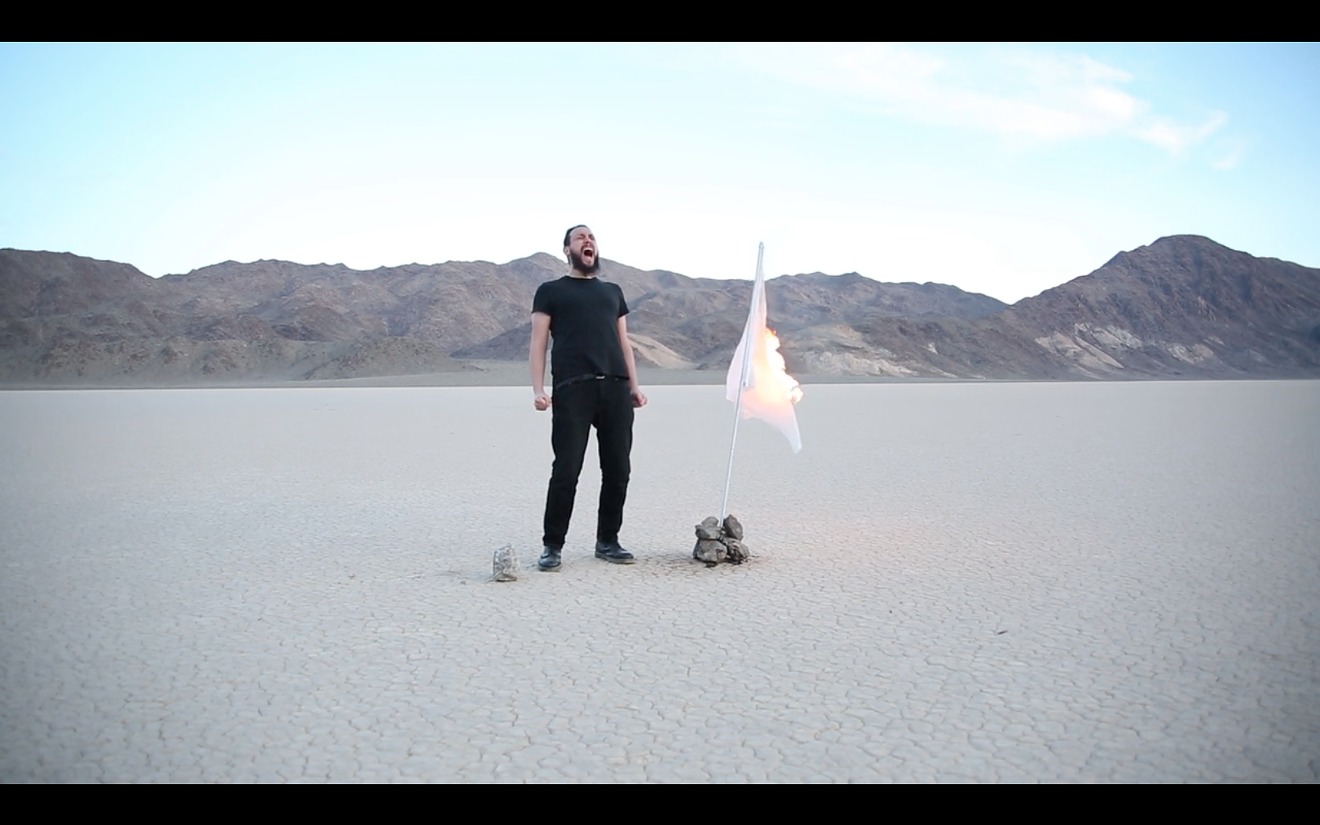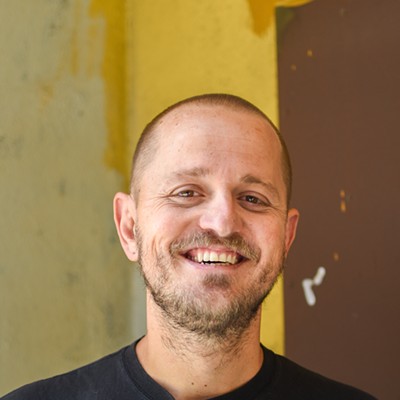None of this is said out of malice. De la Garza, an artist who describes himself as a “dark optimist,” simply wants this city to live up to its cultural potential. While he dislikes a lot of the art he encounters, the rest transforms him intellectually and emotionally, he says, and he just wants more of that.
In his own work, he explores catharsis and power. In a recent sound installation at the DIY gallery Georgia Art Space, he brought audience members into a pitch-black garage and shut the door behind them. From speakers placed throughout the space, drones, whirs and harsh noise traveled across the ceiling, in something akin to what a military interrogator might use to grill a suspect, giving the audience quick training in resisting state interrogation techniques.
De la Garza, whose work has a national audience but is rarely shown in town, is best known in Denver as the programmer behind the experimental media series Collective Misnomer — which isn’t really a collective, but de la Garza isn't fond of the curator label, or the cult of personality that so many curators embrace. The videos he screens in his program are just as aggressive and political as his art: They’re designed to transform the audience, to change us, to shake us up and force us to view the world through a more critical lens. Some are prophetic spasms of rage, while others are refined criticism — and occasionally they're just plain quirky.
While other film organizations and art houses often program their schedules by looking at what’s working at larger institutions and festivals, de la Garza doesn’t pay much attention to that. Instead, he spends a few hours each week surfing Vimeo, watching videos put up by artists. When he likes something he sees, he stores the URL in a Google doc and eventually ties his favorite works together into thematic programs.
Part of what makes de la Garza such a standout programmer is that he has positioned himself as an outsider with regard to Colorado’s experimental-film scene, which has a decidedly backwards-looking bent.
The late avant-garde filmmaker Stan Brakhage, who spent much of his career in Boulder teaching at the University of Colorado, inspired generations of artistic descendants who still imitate him — hand-processing film in homemade chemical baths, scratching celluloid and exploring the spiritual dimensions of the medium. While Brakhage was a critic himself and his work involved a rigorous analysis of the world, the limitations of human perception and the politics of vision, his followers have been less analytical — even if most of their work is produced in an academic context.
De La Garza doesn’t fetishize celluloid. Instead, he programs films and videos that are urgent, responding to the political and ecological moment in which we live. “I love a good video essay,” he says. “I’m not afraid of didactic work.”

"Water Once Ruled" is a terrifying look at the geology of Mars and the ecological crisis on Earth.
"Water Once Ruled"
On Friday, January 25, de la Garza will screen the third installment of a program of short experimental movies, the way things are. the way they are going to be. part three. Part one came in 2016, shortly after Donald Trump’s inauguration, though de la Garza denies that Trump had anything to do with why he started the series.
His concerns are broader than those of this president's administration, rooted in the environmental crisis, the violence of capitalism and police brutality. Before Trump was elected, de la Garza was programming media looking at those issues, he points out, and “even after Trump’s out of office, I’ll still be doing this show.”
The theme of the way things are. the way they are going to be. part three. isn’t cheery: The present is bleak, and the future will be bleak, too. The series opens with Ryan Maxey's “Chocolate Mountain Metal,” an unnerving documentary about an aging man who makes his home on a bombing range; he’s willing to risk being blown to smithereens because it’s cheap living and law enforcement refuses to enter the area, a place where immigrants, drug dealers and criminals pass through to avoid detection.
The second short, John Wilson's “The Road to Magnasanti,” depicts a dystopian future — dreamed up in Sim City — where everything has been built up to look the same, where people are alienated from each other, and where the culture is becoming a soulless utopia for the rich, protected by police violence. Ultimately, it's about the gentrification of New York City, but it has a message for Denver, too.
That’s followed by “Bad Ideas for Paradise,” Emily Vey Duke and Cooper Battersby’s text-heavy experimental meditation on the futility of self-help and building self-esteem.
The fourth piece is “After Fall,” prophetic agit-prop by Colorado artist Kelly Sears for the Now! Journal, a politically radical experimental-film website, that shows what the world could look like if only there were a general strike — something that’s entirely unlikely to happen, especially when so many political movements work in isolation from one another. But, hey, they can dream.
Former Denver artist Christina Battle’s “Water Once Ruled” explores the geology of Mars and how water once carved out canyons across the planet’s surface. Juxtaposing images of Mars with those of violent storms on Earth, the short suggests that life may have once flourished on the Red Planet and then doomed itself through the same kind of ecological crisis humans seem to be causing here. It's suffocating, but smart.
Next up: James Connolly's “Aesthetic Catharsis” examines what happens when people find a way to channel their political rage into sloppy, cathartic phrases like “fascist fuck,” all while showing a grid of images of Republican presidents from Ronald Reagan to George W. Bush to Donald Trump. In the process, it raises the question: When is it okay to call a person in power a fascist, and when is that just a form of release?
The last piece, Michal Mitro's “The Undiscovered Self,” follows a computer reading a section of Carl Jung's "The Undiscovered Self.” The flickering text is a meditation on the state and power, and how individuals are gobbled up by both. It’s a look at the doom we’re facing — ecologically, politically, even personally.
That's a jarring end to a showcase of unsettling cinema — the kind of programming on which de la Garza has built his reputation. The entire the way things are series takes aim at individuals who would rather be consumed by the state or capitalism than fully embrace the riddle that is the self. It’s a dose of medicine without sugar.
Expect to leave the show worried about the world — even Denver. And a little more critical.
the way things are. the way they are going to be. part three. 7:30 p.m. Friday, January 25, Dikeou Pop-Up, 312 East Colfax Avenue, $10, collectivemisnomer.com.














